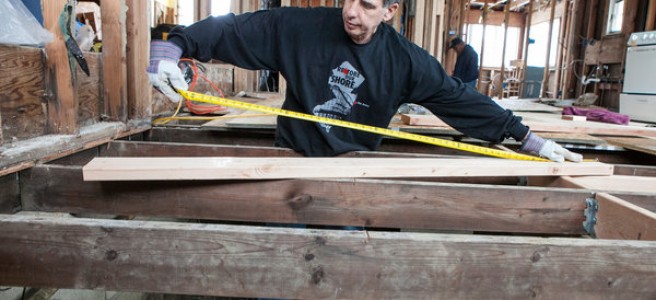NY Times Article - Rebuilding After Hurricane Sandy, but with Costly New Rules

Ron Jampel of Brick, N.J., working on fixing up his home, which took on three feet of water during Hurricane Sandy.
Published: May 10, 2013
It’s been more than six months since Hurricane Sandy hit the East Coast, yet many people whose homes were ravaged by the storm still do not know how to put all the pieces back together.
By now, most know how much insurance money they have to work with, though plenty of people are still struggling to get more. But a new federal law that happened to coincide with the arrival of the storm will cause flood insurance premiums to skyrocket and require stricter, and thus more expensive, rebuilding standards.
So in the most devastated communities, families are being forced to make difficult financial calculations: can they afford the new flood insurance premiums, which, at worst, can reach as high as $30,000 a year? Do they have the money to rebuild their homes to the government’s new specifications? Does it even pay to stay?
Some families have already thrown up their hands and put their houses up for sale, while others talk of making the best of really bad options. “This issue is more devastating to more people than Sandy itself, believe it or not,” said Ron Jampel, a resident of the Shore Acres section of Brick, N.J., who started an advocacy group for affected homeowners in New Jersey called Save Our Communities 2013.
Maria Zanetich, who lives across the street from the water in Point Pleasant, N.J., with her husband and two grown daughters, considers her family lucky in many respects: their first floor is still gutted, but they can continue to live on the top floor of their three-bedroom raised ranch. Their insurance premiums will increase sharply, however, unless they elevate their home five feet, which she said could cost more than $100,000 because their home sits on a concrete slab instead of a foundation with a crawl space.
“I paid my flood insurance on time every year, but I didn’t even know that I had a subsidy, much less one that is now being phased out,” said Ms. Zanetich, who provides early intervention services for children with developmental delays. “The insurance moneys that we received will not cover both elevating my house and repairs.”
She and her husband are applying for grant money — they have already received their flood insurance claim payment — and once they hear about that, they can determine their best course of action. “The more that I try to figure it out,” Ms. Zanetich said, “the more I realize that I don’t know what I don’t know.”
Many people with homes built before the first flood maps were drawn — in New York, for instance, that’s Dec. 31, 1974 — have long received flood insurance at subsidized rates that did not reflect the property’s true risk (though only about 20 percent of flood policy holders nationwide receive these subsidies, according to the Federal Emergency Management Agency). Other homeowners were paying lower rates because the agency failed to update the flood maps, which did not do homeowners — or taxpayers, for that matter — any favors.
“A lot of the maps are so old, they have become unreliable,” said J. Robert Hunter, who once ran the flood program and is now the director of insurance at the Consumer Federation of America. “It’s not doing you a favor to give a cheap rate, and a year later, your house is gone,” he said, adding that it also encouraged unwise construction in certain areas. “Consumer aren’t helped by misleading maps.”
But some of that is about to change with the new law, enacted last July, which is aimed at strengthening the finances of the National Flood Insurance Program. FEMA runs the program but it is administered by private insurers.
The subsidies on these older properties started phasing out for vacation and second homes at the beginning of the year, and will rise by 25 percent annually until the rates reflect the actual risks. Homes with “severe and repeated” flooding will start to see the higher rates on Oct. 1, and also face 25 percent increases each year. Everyone else with a subsidy can keep it, at least until they sell to another owner or the policy lapses. Other properties may face higher rates when their community adopts a new flood insurance rate map (commonly called FIRMs) that shows a higher risk, but the best way to know is to ask your insurance agent. Preliminary maps are being released in New York and New Jersey in coming months, but they will not be formally adopted until late next year.
The new maps estimate the type of flooding that is likely to occur when a so-called 100-year storm sweeps into a specific area and establish a base flood elevation, or the level at which the water is expected to rise to in a storm. So incorporating those maps into rebuilding plans is important. (Early versions have already been released and are not expected to change much, FEMA officials said.)
The insurance premiums are determined, in part, by where your home stands relative to that base. The higher you go, of course, the less you pay. Consider a single-family home in a zone with a moderate to high risk of a flood, that has a flood policy with $250,000 of coverage: if the home is four feet below the base flood elevation, the homeowner would pay an annual premium of about $9,500, according to FEMA. But if the home was elevated to the base, the premium would cost $1,410. Hoist the home three feet higher, and the premium would drop to $427.
Elevating is challenging, if it is even possible, and then there is the bureaucratic morass many people are forced to push through to figure out how to pay for it all. That’s a major reason Chris Buono and his wife, who have two young boys, used their insurance claim money to pay off their mortgage, sell their damaged home in Silverton, N.J., and buy another house nearby but out of the flood zone.
They researched every possibility of saving their home, even considering lopping off the master bedroom and bathroom so the home could fit in their backyard while they installed wood pilings under the home’s original footprint. “It just kept coming down to a lack of solid answers and insanely varying estimates and the chance the bottom could fall out from under you years later in some way,” Mr. Buono, a professional guitarist, said. “Way too risky.”
He said many people he knew who were trying to elevate were scared about what they were getting themselves into. “How is that getting back to normal?” he said. “Living with a financial gun to your head after you paid to be covered.”
Homes in high-risk areas that have been “substantially damaged,” where repairs cost more than 50 percent of the structure’s value before the storm, must be fixed so that it complies with current law. Flood insurance policies do offer an extra $30,000 for this work, including elevation. But many homeowners said that did not begin to cover the added expense.
That’s the case for Will Martone and his wife, Eileen, both 62, who bought a second home on the water in Toms River, N.J., almost three years ago. They planned to work a couple of more years and retire there. But the storm caused more than $100,000 of damage, and their insurance claim paid less than half that. They have hired an advocate to help them recover more money, but that is only part of their problem. They, too, need to raise their home, since it sits below the level at which floodwaters are estimated to rise in the event of another big storm. If he does nothing, Mr. Martone said, his annual flood insurance premiums will soar to $31,000. If he raises his home by five and a half feet, he’ll pay $7,000 a year. And if he goes two feet higher, that will bring the rate down to $3,500.
They are entitled to collect the extra $30,000, but since their split-level home is on a slab, the costs are astronomical. That “puts me in the category of $150,000 plus,” said Mr. Martone, a district facilities manager for Siemens Industry, “which I do not have readily available. So there’s a good chance I’ll lose this home.”
Both New York and New Jersey have outlined their plans for various recovery programs in recent weeks, including community development block grants, even programs that would buy properties in high-risk areas for their pre-Sandy value. But people like Mr. Jampel, the founder of the homeowner’s advocacy group, say they do not believe there will be enough money to go around.
Yet for many homeowners, that’s their only hope. Emily Burek, 28, whose three-bedroom home in Highlands, N.J., took in nine feet of water, received $15,000 from her insurer thus far. But she said that covered only a third of her damages, and she is required to elevate. “Without any money to do that, I will be forced into foreclosure,” she said. “The town says there will be grant money, but they’ve also said a lot of things that turned out not to be true. So I’m not sure if it’s better that I just give up now and cut my losses.”







